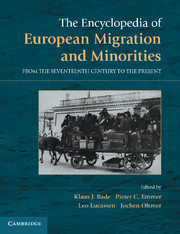Book contents
- Frontmatter
- Contents
- Preface to the English Edition
- Preface to the German Edition
- The Encyclopedia: Idea, Concept, Realization
- Terminologies and Concepts of Migration Research
- Countries
- Northern Europe
- Western Europe
- Central Europe
- Southern Europe
- Italy
- Spain and Portugal
- East-Central Europe
- Southeastern Europe
- Eastern Europe
- APPENDIX
- Index of Migration Types
- Index of Countries, Regions, and Places
- References
Spain and Portugal
from Southern Europe
Published online by Cambridge University Press: 05 June 2012
- Frontmatter
- Contents
- Preface to the English Edition
- Preface to the German Edition
- The Encyclopedia: Idea, Concept, Realization
- Terminologies and Concepts of Migration Research
- Countries
- Northern Europe
- Western Europe
- Central Europe
- Southern Europe
- Italy
- Spain and Portugal
- East-Central Europe
- Southeastern Europe
- Eastern Europe
- APPENDIX
- Index of Migration Types
- Index of Countries, Regions, and Places
- References
Summary
Because of its exposed geographical location between two large seas and as a bridge between Africa and Europe, the Iberian Peninsula has been a region of intense and wide-ranging migration movements since antiquity. Beginning in the Middle Ages, there were already numerous minorities on the Iberian Peninsula, who were given the opportunity – with sometimes more, sometime less, legal restriction – to preserve their linguistic, cultural, or religious identity. Thus the region was home to Jews, to Jews who had converted to Christianity either voluntarily or under coercion, to Moors, Moriscos (forcibly converted Muslims), but also to Christians under Muslim rule with no links to Rome. Added to these were colonies of foreign merchants (nationes), from the 15th century on increasingly individual migrant experts in various occupations (e.g., printers and artists), specialized artisans, merchants, or visitors to fairs in Medina del Campo. Moreover, a significant share of the population in Navarre and northern Catalonia came from France, and from the late Middle Ages the number of slaves of the most diverse backgrounds was on the rise.
The region and its boundaries
After 711, nearly the entire Iberian Peninsula was conquered by Muslim Arabs. The medieval Reconquest of the peninsula gave rise to the expansionary energy of the Christian Iberian kingdoms. Aragon began to expand into the western Mediterranean from the end of the 13th century, taking possession of Sicily and Naples and temporarily even of Greece. At the beginning of the 15th century, Portugal embarked on its expansion to North Africa and in the Atlantic, and around 1480 Castile, too, started to push outward. In a countermove, the Italian trading republics began their commercial penetration of the Iberian Peninsula and projected Mediterranean traditions into the Atlantic.
- Type
- Chapter
- Information
- The Encyclopedia of European Migration and MinoritiesFrom the Seventeenth Century to the Present, pp. 116 - 130Publisher: Cambridge University PressPrint publication year: 2011
References
- 1
- Cited by

